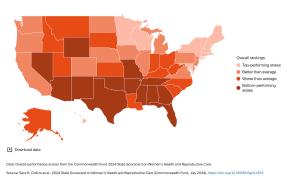A new study ranks Wyoming in the bottom 10 states when it comes to access to women’s reproductive care.
The 2024 State Scorecard on Women’s Health and Reproductive Care, which assesses every state’s health care system based on measures such as maternal mortality, prevention and provider access, ranked Wyoming 42nd. The state came in behind all of its neighboring states.
Wyoming scored especially low in the category of health coverage, access and affordability — at 47th. In health care quality and prevention, the state ranked 43rd, and Wyoming ranked 28th in health and reproductive care outcomes.
The report was put together by The Commonwealth Fund, a 106-year-old private foundation whose stated purpose is to promote a high-performing health care system that achieves better access, improved quality and greater efficiency.
Wyoming’s ranking is unsurprising given that 11 of 23 counties here lack a practicing OB-GYN physician, according to the Wyoming Health Department, and three delivery facilities have closed since 2018. Wyoming has just 16 active midwives licensed under the state board of midwifery. In Fremont County, where access to maternity care has declined significantly over the last five years, average monthly births at Lander’s SageWest Hospital have dropped from around 35 to under 20, health department numbers show.
The situation has the attention of lawmakers and stakeholders. A legislative committee is now studying the various factors contributing to the dearth of maternity care providers and ways to bolster access. A subcommittee of Gov. Mark Gordon’s Health Task Force has also been meeting on the topic for months. Many ideas, but no firm plans, have emerged.
“I wasn’t totally surprised by some of our scores in that we’ve been talking about it and looking at these different things,” said Jen Davis, Gordon’s health and human services policy director. “I think it really does lend to continuing to have these conversations.”
Signs point to women’s health facilities in SageWest Hospital Lander. (Katie Klingsporn/WyoFile)
What the groups’ exploration has underlined is how complicated the issue of maternity care is, she said, and how vital it is to consider all the factors when exploring solutions.
Critical, complicated
A 2023 WyoFile investigation found that significant gaps in Wyoming’s maternity care system prompt families to increasingly travel out of county and out of state to deliver babies, which poses risks to mothers and infants and often comes with bigger costs.
Stakeholders have also pointed out these gaps in care constitute economic threats as young people are more reluctant to move and raise families in a state without quality prenatal and maternity care.
Solutions have been elusive. Complicating the issue are provider challenges like low birth volume in rural areas, high costs of medical malpractice insurance, financial viability struggles for hospitals, abortion legislation’s impacts on doctors, liability concerns and barriers for midwives to deliver in hospitals.
The Joint Labor Committee made Wyoming’s maternity care shortage its No. 1 interim priority, along with childcare. That means the members are studying it before the next session with the aim of drafting legislation.
At the same time, the governor’s Health Task Force’s OB Subcommittee has been meeting regularly to explore solutions Wyoming could adopt to bolster access to the critical services of maternity care.
“Unfortunately, it is a super complicated topic in Wyoming, just like all of rural medicine,” Davis told the Labor Committee in June. After delving into the intricacies, she said, the subcommittee has identified three main areas of interest: how to better utilize midwives, doulas and family physicians alongside obstetricians in delivery care; the possibility of creating OB medical fellowships to bolster care in Wyoming and regionalizing the state’s maternity care.
“It’s definitely solvable, but we just need to have those meaningful conversations with each other about how do we meet the needs of our Wyoming citizens,” Davis said. “I just think we need to be real intentional as we do this, because if we do one thing, it has an impact on [other factors].”
Between the lawmakers, doctors, OB-GYNs, midwives and medical experts on the governor’s task force and the legislative committee, Davis told WyoFile, she is confident the groups can identify initiatives to improve Wyoming’s maternity care landscape.
In the Labor Committee’s two interim meetings thus far, members have discussed solutions that range from tort reform to creating midwife training opportunities in community colleges.
Labor Committee member Sen. Fred Baldwin (R-Kemmerer), a physician assistant who has been attending the subcommittee meetings, noted at the June meeting the problem doesn’t always come down to not enough doctors.
“We can’t just simply plug a provider into that location if there’s not enough patients,” Baldwin said.
“There’s a lot of nuances to this, it’s not just simply a matter of getting enough providers,” he continued. “Regionalization is one of those concepts to look at, and I think it’s an important concept to look at.”
Policy impacts
Declining access to maternity care is not isolated to Wyoming. Over the past decade, more than 200 rural hospitals across the country have stopped delivering babies. The trend spurred the national scorecard, according to the Commonwealth Fund report.
“Clearly, women’s health is under threat,” the report states. “That’s why the Commonwealth Fund has developed the first-ever state scorecard to track trends in women’s health over time and document how policy choices and judicial decisions may impact women’s access to timely health care.”
The report touched on state policy that influences the issue, pointing out that 10 states have yet to expand eligibility for Medicaid while 21 states have tightened or imposed new limits or bans on abortion.
Wyoming has not expanded Medicaid eligibility. The state has also passed bans on abortion since the U.S. Supreme Court overturned Roe v. Wade, but the procedure is still legal here as the bans are tied up in litigation.
The Joint Labor Committee is expected to revisit the issue when it meets Aug. 29-30 in Cheyenne.
The post Why Wyoming ranks 42nd on women’s reproductive health care scorecard appeared first on WyoFile .

